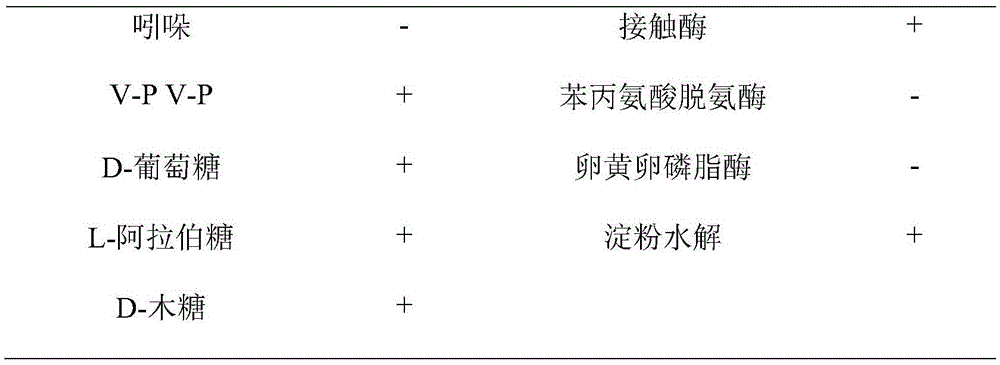Bacillus amyloliquefaciens strain W1 for controlling plant spider mites and application
A technology of amylolytic spores and plant leaves, applied in the fields of application, plant growth regulators, botany equipment and methods, etc., which can solve problems such as poor control effect, poor development and utilization value, and unclear active ingredients
- Summary
- Abstract
- Description
- Claims
- Application Information
AI Technical Summary
Problems solved by technology
Method used
Image
Examples
Embodiment 1
[0022] Example 1 The acquisition, identification, culture preservation and preservation of Bacillus amyloliquefaciens strain W1CGMCC No. 11949 (hereinafter referred to as: strain W1) of the present invention.
[0023] 1 Isolation and screening of strain W1
[0024] 1.1 Isolation of strain W1
[0025] Find the naturally dead Tetranychus urticae from the corn leaves, put the Tetranychus urticae into a sterile concave glass slide, disinfect the surface with 75% (v / v) alcohol for 1 min, and wash it with sterile water for 5 times Use sterile filter paper to blot the water on the surface of Tetranychus urticae, put Tetranychus urticae into a sterile mortar, add sterile water, after grinding, suck the grinding solution onto the LB medium plate, and spread it evenly with a triangle At the same time, absorb the same amount of sterile water rinse solution for the third time and smear the plate to test whether the surface of Tetranychus urticae is thoroughly disinfected; finally, place ...
Embodiment 2
[0044] The optimization of embodiment 2 bacterial strain W1 fermentation conditions
[0045] 1. Single factor experimental design
[0046] Take out the strain W1 stored in the -80°C refrigerator, streak it on the LB solid plate for overnight culture and activation, pick a single colony the next day, inoculate it in the LB liquid medium with a pH of 7, and ferment at 37°C and 160rpm for 24 hours For fermentation, the fermented liquid was inserted into a 500mL fermentation bottle equipped with 150mL fermentation medium according to the inoculum amount of 5%, cultivated in a constant temperature shaker at 37°C and 160rpm for 24h, set three repetitions, and mixed the three repeated fermented liquids evenly. Determination of OD of bacterial culture 600 value. At the same time, the sample was serially diluted 10 times with sterile water, and 10 -6 cfu / ml, 10 -7 cfu / ml and 10 -8 cfu / ml concentration gradient dilution, transferred to the pre-poured LB solid plate (200 μl / dish), s...
Embodiment 3
[0053] Colonization ability determination of embodiment 3 bacterial strain W1
[0054] 1. GFP marker of strain W1
[0055]Take out the strain W1 stored in the -80°C refrigerator and streak it on the LB solid plate for overnight culture and activation. Pick a single colony the next day and inoculate it in 5mL of GMI medium, culture it overnight at 30°C with 150rpm shaking, and transfer to 10% of the inoculum. Inoculate in 5mL GMI medium, shake at 37°C and 230rpm for 3.5h, take the fermentation liquid and inoculate it in 5mL of GMII medium according to the inoculum size of 5%, culture at 37°C and shake at 230rpm for 1.5h, take 1mL culture, centrifuge at room temperature at 5000rpm for 5min, Resuspend the bacterial pellet with 1 / 10 volume of the supernatant, namely Bacillus amyloliquefaciens strain W1 competent cells. Add 10 μL of plasmid pEGFP-C1 (pEGFP-C1 was purchased from Bao Biological Engineering (Dalian) Co., Ltd.) into the prepared Bacillus amyloliquefaciens strain W1 co...
PUM
| Property | Measurement | Unit |
|---|---|---|
| Corrected death rate | aaaaa | aaaaa |
Abstract
Description
Claims
Application Information
 Login to View More
Login to View More - R&D
- Intellectual Property
- Life Sciences
- Materials
- Tech Scout
- Unparalleled Data Quality
- Higher Quality Content
- 60% Fewer Hallucinations
Browse by: Latest US Patents, China's latest patents, Technical Efficacy Thesaurus, Application Domain, Technology Topic, Popular Technical Reports.
© 2025 PatSnap. All rights reserved.Legal|Privacy policy|Modern Slavery Act Transparency Statement|Sitemap|About US| Contact US: help@patsnap.com


